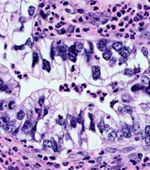Cytokine Signaling Through JAK2/STAT3 Pathway is a Viable Therapeutic Target in NSCLC
Addition of a Janus kinase 2 (JAK2) inhibitor to therapies that target commonly altered oncogenes such as KRAS or EGFR could improve clinical outcomes for patients with non–small cell-lung cancer.
Addition of a Janus kinase 2 (JAK2) inhibitor to therapies that target commonly altered oncogenes such as KRAS or EGFR could improve clinical outcomes for patients with non–small-cell lung cancer (NSCLC), according to Brendan D. Looyenga, PhD, of the Van Andel Research Institute, Grand Rapids, Michigan (AACR abstract 168).

Clear-cell adenocarcinoma of the lung
The emergence of molecular methods for classifying solid tumors based upon specific “driver mutations” has made rationally designed chemotherapy possible in a variety of cancers, including NSCLC, explained Dr. Looyenga. NSCLC is routinely treated with targeted kinase inhibitors such as erlotinib (Tarceva) and gefitinib (Iressa).
“Despite the success of this approach,” said Dr. Looyenga, “drug resistance continues to be a significant problem in patients with advanced NSCLC.”
Constitutive activation of signal transducer and activator of transcription 3 (STAT3) is a common feature in NSCLC and has been proposed to play an important role in tumor cell resistance to conventional and targeted small-molecule therapies. “We analyzed the activation status of key growth factor signaling pathways in seven NSCLC lines with four distinct classes of driver mutations,” said Dr. Looyenga.
Targeted pharmacologic inhibitors were used to evaluate the relative contribution of each oncogene to signaling pathway activation. “We observed that STAT3 remained activated in all seven cell lines independent of mutational subtype.” Pharmacologic or genetic inhibition of the gp130/JAK2 signaling pathway, however, uniformly disrupted STAT3 activation.
At the functional level, treatment of cells with the JAK1/2 inhibitor ruxolitinib (Jakafi) had little effect on proliferation and viability in 2-dimensional culture, though it inhibited anchorage-independent growth of NSCLC cells in soft agar, said Dr. Looyenga.
Ruxolitinib also slowed growth of xenografted NSCLC cells, indicating that JAK2 activity is required for optimal growth of lung tumors in vivo. “Together,” he concluded, “these results demonstrate that JAK2/STAT3 signaling operates independent of known driver mutations in NSCLC and may play a key role in growth and/or progression of lung tumors.”
Newsletter
Stay up to date on recent advances in the multidisciplinary approach to cancer.